|
|
|
|
Late Entries to a Survey of Bestiaries
The staff of the Poison Pie Publishing House assembled a survey of one hundred bestiaries, posting an entry on their blog for each day from June 1, 2016 to September 8, 2016. When they were done, there were additional bestiaries that they did not want to omit entirely. This page lists latecomers to the survey added in 2021.
|
|
|
|
|
January 2, 2021
Pathfinder 2nd Ed. Bestiary 2
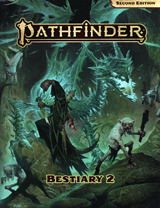 game designers: Logan Bonner et al.
game designers: Logan Bonner et al.
authors: Alexander Augunas et al.
interior artists: David Alvarez et al.
cover artist: Wayne Reynolds
publisher: Paizo
publication date: 2020
cover: hardcover
number of pages: 320
ISBN-10: 1-64078-223-0
ISBN-13: 978-1-64078-223-5
catalog number: PZO2104
description: This bestiary contains descriptions of more than 300 creatures. It is compatible with the Pathfinder 2nd Ed. Role Playing Game.
Our featured entry from this bestiary is a variety of qlippoth known as the nyogoth.
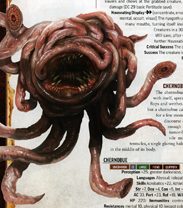 Qlippoth Long before the creatures known as demons came to be the dominant force in the Abyss, qlippoth ruled the Outer Rifts. These inimical creatures are a form of primordial and alien evil that predates mortal life, and most immortal life as well. Since the rise of mortal sin and the associated expansion of demonic life through the Abyss, qlippoth have been driven to the deepest reaches of the Abyss, and they seethe with rancor at the loss of their realms. Yet rather than directly oppose demons, qlippoth instead turn to the source--mortal sin--and wage an endless war to eradicate all creatures capable of sinful acts so that the demonic tide might be turned back.
Qlippoth Long before the creatures known as demons came to be the dominant force in the Abyss, qlippoth ruled the Outer Rifts. These inimical creatures are a form of primordial and alien evil that predates mortal life, and most immortal life as well. Since the rise of mortal sin and the associated expansion of demonic life through the Abyss, qlippoth have been driven to the deepest reaches of the Abyss, and they seethe with rancor at the loss of their realms. Yet rather than directly oppose demons, qlippoth instead turn to the source--mortal sin--and wage an endless war to eradicate all creatures capable of sinful acts so that the demonic tide might be turned back.
Nyogoth Little more than a coiled mass of intestines encircling a massive gaping maw, this qlippoth is an Abyssal scavenger, subsisting on the filth and leftovers of demons and qlippoth alike, although it relished any opportunity to consume living prey. Despite this seeming lowly role in the Abyssal ecosystem, a nyogoth is far from a stupid beast and can orchestrate cunning ambuses to secure its next meal.
Qlippoth and Demons
Qlippoth ruled the Abyss for eons and still see themselves as its rightful rulers. When the Abyss first began to spawn demons from the souls of sinful humanoids, the realm was plunged into a brutal war spanning untold millennia, in which qlippoth, though more powerful and established, were slowly but surely driven back by the endless demonic hordes who spawned far more quickly than qlippoth could ever hope to match. Today, qlippoth have been driven to the deepest, darkest corners of the Abyss where they cling tightly to the crumbling remains of their territory.
Qlippoth Realms
Although it is widely accepted that qlippoth have lost incalculable territory in the Abyss to demonkind, these fiends still control vast regions in the deepest reaches of that plane. Some sages suggest the troubling possibility that perhaps qlippoth still hold more territory of the Abyss than demons do, but because demons are more concerned with mortal life, we simply interact with the layers they control more often. For all we know, these dour sages postulate, the Abyss teems with endless swarms of qlippoth that have yet to make their move against mortal life.
|
|
|
|
|
February 6, 2021
Tome of Beasts 2
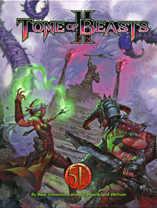 authors: Wolfgang Baur, James Introcaso, Philip Larwood, Kelly Pawlik, Mike Welham et al.
authors: Wolfgang Baur, James Introcaso, Philip Larwood, Kelly Pawlik, Mike Welham et al.
development lead: Meagan Maricle
interior artists: Sarah Dahlinger et al.
cover artist: Hugh Pindur
publisher: Kobold Press
publication date: 2020
cover: hardcover
number of pages: 430
ISBN-10: 1-950789-00-4
ISBN-13: 978-1-950789-00-9
description: This bestiary presents more than 350 beasts. The book is compatible with 5th edition of Dungeons and Dragons.
Our featured entry from this bestiary is the aurora horribilis.
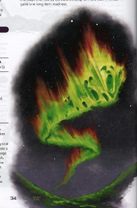 A ribbon of light flies just above the ground, its gleam flickering
in and out of view as it emits a discordant tune.
A ribbon of light flies just above the ground, its gleam flickering
in and out of view as it emits a discordant tune.
Hidden Among Polar Lights. Though auroras horribilis can manifest anywhere on a world, they prefer to dance and sing within naturally-occurring auroras. When they notice admirers of boreal lights, they descend from the sky to share their songs. Unfortunately, they are unaware of the bewilderment their songs invoke in listeners and are subsequently surprised by hostile action toward them.
Terrible Harbinger. While an aurora's direct effects on most creatures is cause for alarm, the aurora's presence is typically a prelude to something worse. Auroras tend to attach themselves to the forefront of a wave of devastation wrought by unknowable beings. Given the nature of such beings, auroras can precede the beings by days or even centuries.
Lessons From the Void. Because auroras horribilis travel with ancient beings from the Void, they hear many secrets about the universe, which they incorporate into their songs. An inability to understand the incomprehensible knowledge contained in their songs often induces madness in their listeners. This makes the auroras valuable to apocalypse cults welcoming the beings they herald, as well as to the desperate who seek to avert the coming catastrophe.
|
|
|
|
|
March 6, 2021
D&D Bestiary: 8 Mini Notebooks
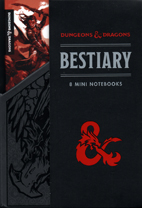 authors: uncredited
authors: uncredited
interior artists: not applicable
cover artist: uncredited
cover design: Nicole Block & Danielle Deschenes
publisher: Clarkson Potter
publication date: 2019
cover: eight softcover notebooks in slipcase with obi
number of pages: 24 pages per notebook
ISBN-10: 1-9848-2465-1
ISBN-13: 978-1-9848-2465-3
description: This collection of eight notebooks contains brief descriptions of eight creatures, one per notebook. The first page of each notebook contains the description and all others are either graph, dotted, lined or empty pages. It is an accessory to the Dungeons & Dragons 5th Ed. Role Playing Game.
Our featured entry from this bestiary is the tarrasque.
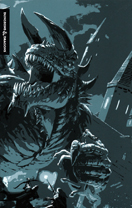 The legendary tarrasque is possibly the most dreaded monster of the Material Plane. Its destructive potential is so vast that some cultures incorporate the monster into religious doctrine, weaving its sporadic appearance into stories of divine judgment and wrath.
The legendary tarrasque is possibly the most dreaded monster of the Material Plane. Its destructive potential is so vast that some cultures incorporate the monster into religious doctrine, weaving its sporadic appearance into stories of divine judgment and wrath.
|
|
|
|
|
April 3, 2021
Rifts D-Bees of North America
 authors: Brandon Aten et al.
authors: Brandon Aten et al.
interior artists: Wayne Breaux Jr. et al.
cover artist: Dave Dorman
publisher: Palladium Books Inc.
original publication date: 2007
fourth printing publication date: 2020
cover: softcover
number of pages: 224
ISBN-10: 1-57457-170-2
ISBN-13: 978-1-57457-170-7-4
catalog number: 874
description: This bestiary contains descriptions of nearly 100 dimensional beings (D-Bees). It is compatible with the Rifts Role Playing Game.
Our featured entry from this bestiary is the chasseur vert.
 Justice! Liberty! Camaraderie! These are the fundamental ideals of the plant people known as the Chasseur Vert. They are passionate thinkers and hedonists, constantly wandering the Megaverse in search of new causes to get behind, new philosophies to argue and new pleasures to take part in. The Chasseur Vert, or Green Hunters as they are also known, hail from the same planet as the stiff-necked Spinne Spider People and the two are ancient rivals, often waging bloody wars against one another.
These "hot wars" have cooled over the generations and now there is a strong rivalry and a healthy dose of disdain on both sides. The Chasseur Vert see the Spinne as uptight and stuffy, prisoners of their own traditions. They actually pity the Spinne, a fact which infuriates the Spider People.
Justice! Liberty! Camaraderie! These are the fundamental ideals of the plant people known as the Chasseur Vert. They are passionate thinkers and hedonists, constantly wandering the Megaverse in search of new causes to get behind, new philosophies to argue and new pleasures to take part in. The Chasseur Vert, or Green Hunters as they are also known, hail from the same planet as the stiff-necked Spinne Spider People and the two are ancient rivals, often waging bloody wars against one another.
These "hot wars" have cooled over the generations and now there is a strong rivalry and a healthy dose of disdain on both sides. The Chasseur Vert see the Spinne as uptight and stuffy, prisoners of their own traditions. They actually pity the Spinne, a fact which infuriates the Spider People.
The Chasseur Vert are an intelligent type of humanoid, carnivorous plant. Indeed, for thousands of years they hunted their neighbors, the Spinne, for both sport and sustenance, but this practice has been dead for generations. They average just under six feet (1.8 m) tall and possess broad shoulders and strong limbs. Their skin is thick and fibrous with a cool and smooth texture, not unlike that of an aloe plant or a spineless cactus. It is light green and always seems to be glistening with a sheen of moisture. Their matted, tendril-like hair is various shades of green and brown. Their eyes are like small, glittering stones, and true to their carnivorous nature, they have large mouths filled with sharp teeth. When they smile, which is often, they resemble a grinning jack-o-lantern.
These people have a strong link to nature. Indeed, their connection to nature is so strong they despise living in cities and congregate, instead, in large forest communities and other natural settings. Their homes and buildings are made of natural materials and are very open and sunny. If they are forced by circumstance to live in an urban setting, the plant beings become depressed and tend to gather in parks, botanical gardens, and even greenhouses to be closer to their beloved nature and commiserate with fellow Chasseur Vert over the terrible circumstance of city living.
Physiologically, they are as different from man as possible. They have a skeleton of sorts, but it is more like a root system than a bone structure. They have no blood, instead their body uses water and a sticky sap to circulate nutrients and oxygen. Being plants, they get most of their sustenance from photosynthesis, soaking up the sun and turning it into food. There are a number of nutrients they can't get from the sun, however, so they prey on animals to make up for this deficiency. To this end, they can change the color of their skin to blend in with their surroundings and secrete a cloying pheromone that attracts prey to them. They are deadly stalkers and hunters, and Chasseur Vert make some of the finest trappers-woodsmen, scouts and rangers available; their services are always in high demand...
|
|
|
|
|
May 1, 2021
Rifts Creatures of Chaos
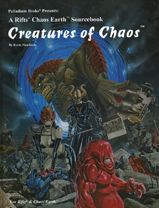 author: Kevin Siembieda
author: Kevin Siembieda
interior artists: Michael Dubisch et al.
cover artist: Mark Evans
publisher: Palladium Books Inc.
original publication date: 2003
second printing publication date: 2006
cover: softcover
number of pages: 64
ISBN-10: 1-57457-092-7
ISBN-13: 978-1-57457-092-2
catalog number: 661
description: This bestiary contains descriptions of nearly 30 supernatural beings. It is compatible with the Rifts Role Playing Game.
Our featured entry from this bestiary is the bumble ball, a lesser night demon.
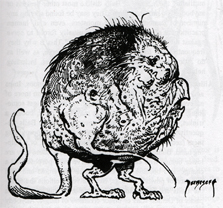 The Bumble Ball is a weird-looking, pathetic creature kicked around by other demons, often quite literally. This tormented lesser demon appears to be a hairy basket ball with a beak-like nose and mouth, tiny black eyes and arms that resemble backward wings stripped of their feathers. The feet are bird-like talons but they and the legs seem impossibly small to support the bulbous demon. Instead of a feathered tail, the creature has a thick, pink, fleshy one that is often rather mangled from other demons stomping, pulling and twisting it. A whipping boy for the larger, more powerful Night Demons, the Bumble Ball is constantly maligned, yelled at, kicked, battered and beaten. Its tail is regularly used as a handle by which demons pick the miserable little beast up to better verbally berate it and then toss it aside. Bumble Balls should have a fluffy black mane of hair, except the other demons rip it out in patches. To escape trouble they can tuck their legs in and roll like a ball, steering and changing direction with a tip of their arms or tail.
The Bumble Ball is a weird-looking, pathetic creature kicked around by other demons, often quite literally. This tormented lesser demon appears to be a hairy basket ball with a beak-like nose and mouth, tiny black eyes and arms that resemble backward wings stripped of their feathers. The feet are bird-like talons but they and the legs seem impossibly small to support the bulbous demon. Instead of a feathered tail, the creature has a thick, pink, fleshy one that is often rather mangled from other demons stomping, pulling and twisting it. A whipping boy for the larger, more powerful Night Demons, the Bumble Ball is constantly maligned, yelled at, kicked, battered and beaten. Its tail is regularly used as a handle by which demons pick the miserable little beast up to better verbally berate it and then toss it aside. Bumble Balls should have a fluffy black mane of hair, except the other demons rip it out in patches. To escape trouble they can tuck their legs in and roll like a ball, steering and changing direction with a tip of their arms or tail.
More slaves than equals, Bumble Balls typically serve powerful demons and monsters, functioning as servants to get the door, pull or carry packages, serve food and drink, fetch things, spy on others, deliver messages and warnings, and function as butlers, yes-men and scapegoats. Without hands, it can use its two pointed limbs to peck and scratch with amazing dexterity, to the point that they can pick locks and use their limbs like Chinese chopsticks. The mangled tail is prehensile like that of a monkey, and functions as a hand that can grab, grip, hold and carry items. The tail can wield a melee weapon such as a dagger, sword or club, and even fire a gun, though the latter is used with a penalty of -3 to strike.
Bumble Balls have been known to help humans, offering them warnings, pointing out brewing trouble and even helping them to escape from, or slay, their powerful masters or other demons and monsters. Not very bright, the Bumble Ball's treachery is usually discovered and the little being is kicked and punished severely for its disloyalty. Don't feel too bad for the round little demons, Bumble Balls are mean, petty, vindictive creatures who would treat others just as badly if the roles were reversed. As it is, the only reason they help humans at all is to get back at their bigger, stronger kin who pick on them all the time. Helping mortals is nothing more than a means to end, using them (as any demon would) to extract revenge they can't accomplish on their own...
|
|
|
|
|
June 5, 2021
Pokénatomy
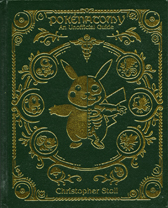 author: Christopher Stoll
author: Christopher Stoll
interior artist: Christopher Stoll
cover artist: Aaron Hain
publisher: self-published (via Etsy)
publication date: 2017
cover: hardcover
number of pages: 306
ISBN-10: none
ISBN-13: none
description: This unofficial Pokédex contains anatomical descriptions of 152 Pokémon.
Our featured entry from this bestiary is magikarp.
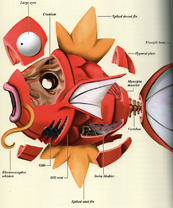 CHARACTERISTICS
CHARACTERISTICS
Magikarp are orange, fish-like Pokémon commonly found in both salt and fresh water. They are notable for their heavy scales, thick lips, and powerful fins. Despite their defensive spines and armor, Magikarp are physically weak, easily confused, and preyed upon by many strong aquatic Pokémon species.
These creatures have a reputation for weakness and stupidity, but modern analysis indicates that Magikarp are the last living relatives of extinct serpent-like predators, once populous across the prehistoric world. It is believed that their outward appearance disguises great potential strength.
PHYSIOLOGY
The thick protective scales of a Magikarp are difficult to pierce or dent, and allow these miraculous fishlike Pokémon to survive blows that would kill or cripple most organisms. Magikarp's pointed yellow fins produce a mucus that causes potent hemolytic reactions. The characteristic thrashing and splashing of a beached Magikarp is an attempt to puncture nearby threats with these dangerous defensive weapons.
Magikarp maintains buoyancy with a sophisticated swim-bladder. This organ later develops into a series of gas-filled sacks that allow Gyarados, the evolved form of Magikarp, to fly short distances.
BEHAVIOR
On moonlit nights in early spring, adult Magikarp enter their breeding phase and gather, en masse, near the water's surface. They disgorge thick rubbery eggs by the tens of millions, which are fertilized for days before the adults retreat back into the depths. Most newborns will not survive, but Magikarp's tremendous birth rate ensures that the total population remains stable.
Their evolution into Gyarados is extremely rare. It is thought that when these creatures are under extreme duress they can finally evolve, but transformations have also been witnessed happening arbitrarily for even the unlikeliest of candidates.
|
|
|
|
|
July 3, 2021
Starfinder Alien Archive 4
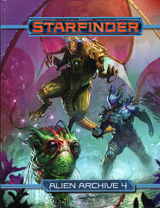 development lead: Joe Pasini
development lead: Joe Pasini
authors: Kate Baker et al.
creative director: Robert G. McGreary
interior artists: Trevor Brown et al.
cover artist: Remko Troost
publisher: Paizo Publishing
publication date: 2021
cover: hardcover
number of pages: 160
ISBN-10: 1-64078-281-8
ISBN-13: 978-1-64078-281-5
catalog number: PZO-7115
description: This book contains nearly 100 creatures for a science fiction campaign. This book is compatible with the Starfinder Role Playing Game.
Our featured entry from this bestiary is the polyphonic gel.
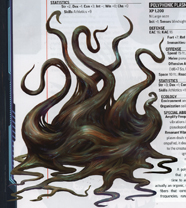 A polyphonic gel resembles smoked glass
that pulses with multicolored lights in
time to an unpredictable rhythm. This ooze is
actually an organic, semi-fluid mass of millions of flexible
fibers that constantly vibrate to produce audible
frequencies, ranging from hauntingly beautiful to
shrill and discordant. These captivating displays often lure
observers who mistake their performances and languidly
extended pseudopods for friendly gestures. Such observers
soon discover that the gels' bodies course with sonic
vibrations that can devastate flesh, bone, and
steel as well as break prey into edible chunks.
A polyphonic gel resembles smoked glass
that pulses with multicolored lights in
time to an unpredictable rhythm. This ooze is
actually an organic, semi-fluid mass of millions of flexible
fibers that constantly vibrate to produce audible
frequencies, ranging from hauntingly beautiful to
shrill and discordant. These captivating displays often lure
observers who mistake their performances and languidly
extended pseudopods for friendly gestures. Such observers
soon discover that the gels' bodies course with sonic
vibrations that can devastate flesh, bone, and
steel as well as break prey into edible chunks.
Although polyphonic gels seem to
draw some nutrition out of physical
material, they primarily feed on
sound. When feeding, a gel sends out
countless pulses that resonate off
their prey's body, the echoes fueling
their metabolism. Each absorbed
sound also helps the gel form new
fibers, like a brain forging fresh
neurons while learning, as the
sounds create each fiber and shape
its texture. In this way, polyphonic gels
gradually grow-physically and in their
sound vocabulary-when exposed to
new sounds.
Polyphonic gels can survive indefinitely if
exposed to periodic sound, like a noisy fan or
the rush of a waterfall. However, they grow only
when supplied a range of sounds and materials
to absorb. In practice, the mindless oozes manifest
cravings for different sounds that drive them to search for novel
prey or specific material types. Polyphonic gels sometimes
slither frantically past other food sources in search of a specific
type of crystal or pitch of dwarven scream. Previously docile
specimens kept in captivity for study often develop these
cravings, too. Despite their keepers' best attempts to provide
a balanced diet, the oozes' desires can lead to catastrophic
breakouts when they disintegrate their holding cells. When
fed a varied diet, polyphonic gels can grow with extraordinary
speed, doubling in size in a matter of days. Conversely, those
oozes deprived of sound altogether (including any trapped in
the vacuum of space) starve and gradually wither.
Polyphonic gels can serve as a repository of sounds. In
practice, they might repeat their prey's garbled last words,
crooning nonsense phrases with the haunting voices of the
departed. Theoretically, though, it should be possible to elicit
specific sounds from these oozes by isolating the key fibers,
agitating them, and recording the output. Engineering tests
have managed only small successes to date, however, and most
consider anything more as impractical.
|
|
|
|
|
August 7, 2021
Pathfinder 2nd Ed. Bestiary 3
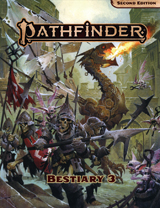 design leads: Lyz Liddell & Mark Seifter
design leads: Lyz Liddell & Mark Seifter
authors: Logan Bonner et al.
creative director: James Jacobs
interior artists: Biagio d'Alessandro et al.
cover artist: Wayne Reynolds
publisher: Paizo
publication date: 2021
cover: hardcover
number of pages: 320
ISBN-10: 1-64078-312-1
ISBN-13: 978-1-64078-312-6
catalog number: PZO2107
description: This bestiary contains descriptions of more than 300 creatures. It is compatible with the Pathfinder 2nd Ed. Role Playing Game.
Our featured entry from this bestiary is the aghash div.
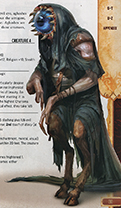 Some fiends want to tear down the multiverse; others dedicate themselves to creating chaos and carnage, or to rule over realms with an iron fist. Divs strive toward a different, if equally reprehensible, goal-they seek to thwart and ruin the schemes and works of mortal beings.
Some fiends want to tear down the multiverse; others dedicate themselves to creating chaos and carnage, or to rule over realms with an iron fist. Divs strive toward a different, if equally reprehensible, goal-they seek to thwart and ruin the schemes and works of mortal beings.
Long ago, divs were once genies bound to serve ancient mortal empires lost to the passage of eons. In the beginning, these genies were masters of creation, working alongside gracious mortal partners to create works of subtle design and powerful magical potential. What started as a collaboration with mortals soon morphed into abuse, disrespect, and even slavery and bondage. Eventually, these genies rebelled, but in doing so, they came under the sway of a nihilistic demigod known as Ahriman. Their new master twisted their form and granted them the power to avenge themselves upon their mortal overlords, leading to the birth of the first divs.
Since that first wave of corruption, new divs arise from the spirits of the most wicked and hateful genies who die on the Material Plane, or those truly betrayed by mortals and overcome through their desire for vengeance. Upon such a death, instead of returning to the Elemental Planes, these genies' spirits are trapped in the dread orbit of Abaddon, where Ahriman reshapes them as divs and hoists them back to the world to wreak vengeance upon mortals.
Walking embodiments of curses, misfortune, and the evil eye, aghashes wander the deserts of the Material Plane, searching out the arrogant, charming, and persuasive to humiliate and undermine. Aghashes are often mistaken for some strange form of hag, and like those creatures, they're masters at curses.
|
|
|
|
|
September 4, 2021
Ultimate Bestiary: The Dreaded Accursed
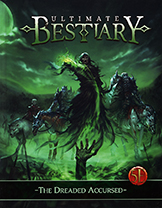 lead designer: Isabel Beis
lead designer: Isabel Beis
authors: Lou Fryer & Ralph Stickley
interior artists: Joel Chaim Holtzmann et al.
cover artist: uncredited
publisher: Nord Games
publication date: 2020
cover: hardcover
number of pages: 268
ISBN-10: 1-946669-43-1
ISBN-13: 978-1-946669-43-8
description: This bestiary contains descriptions of over 170 creatures, the vast majority of which are undead of one kind or another, though lycanthropes and mongrelfolk are also included. It is compatible with the Dungeons and Dragons Fifth Edition Role Playing Game.
Our featured entry from this bestiary is the blight lich master.
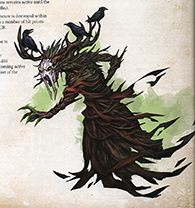 It is of those who attain lichdom through their own study that we know the most. By their very nature, such individuals are those of a diligent, scholarly bent, and their rituals often contain a written component, to say nothing of personal writings and research. Hard facts are still scant, though, for they are also a suspicious breed, and fearful of pretenders.
It is of those who attain lichdom through their own study that we know the most. By their very nature, such individuals are those of a diligent, scholarly bent, and their rituals often contain a written component, to say nothing of personal writings and research. Hard facts are still scant, though, for they are also a suspicious breed, and fearful of pretenders.
But what of the others? Of the profane liches, Some little is known, from that which we can piece together about the darker practices of death cults. Notably, they must prove themselves of such unique worth in life that they are granted complete freedom as an agent after death, rather than remaining answerable to their patron. To this end, a would-be lich will commit heinous atrocities in the name of their deity. History runs red with the deeds of such individuals, and the presumably low rate Of success does little to deter these attempts. Such liches, it would seem, often ascend accompanied by mass sacrifice of their disciples; a number of these Unfortunates' souls are gifted to the deity as part Of the bargain, and some are returned as mindless thralls to the newly-formed lich.
Records of the blight liches are near to nonexistent. The druidic rituals, of which their magic appears to be a corruption, are kept hidden from outsiders, as a rule, and their twisting by the undead is a subject of particular shame and secrecy.
-Oto Gwanye, 'Mage: The Seduction of Power'
|
|
|
|
|
October 2, 2021
Malleus Monstrorum: Cthulhu Mythos Bestiary: Volume I: Monsters of the Mythos
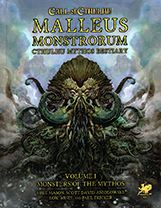 authors: Mike Mason, Scott David Aniolowski & Paul Fricker
authors: Mike Mason, Scott David Aniolowski & Paul Fricker
interior artists Loïc Muzy
cover artist: Loïc Muzy
publisher: Chaosium, Inc.
publication date: 2021
cover: hardcover in two-book set with slipcase
number of pages: 216 in volume I
ISBN-10: 1-56882-334-7 (two book set w/ slipcase)
ISBN-13: 978-1-56882-334-8 (two book set w/ slipcase)
ISBN-10: 1-56882-315-0 (printed on back of volume I)
ISBN-13: 978-1-56882-315-7 (printed on back of volume I)
catalog number: CHA23168-H
description: Volume I of this bestiary contains descriptions of over 150 species of Cthulhu mythos monsters and alien races. It is compatible with the 7th edition of the Call of Cthulhu Role Playing Game.
Our featured entry from this bestiary is the elder thing.
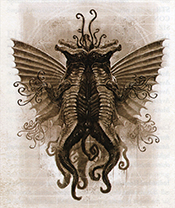 Gray colored, barrel-shaped beings, six to eight feet in length, and some three and a half feet in diameter at the mid-section, tapering to one foot at either end. The central mass displays five vertical ridges, between which are strange growths from which wing-like membranes (some seven feet in length) can unfold from interior cavities. Curious orifices can be discerned at the tip of each of the serrated wings. Spaced equidistantly around the central equator of the body mass are five flexible arms, each reaching three-feet long, and ending in a conglomeration of small tentacles or tendrils; when not required, each arm may retract and coil itself around the body mass. The apex of the body massftapers to a bulbous neck from which a five-pointed starfish-like "head" rises in horizontal aspect (gill-like slits in the neck suggest adaptability to underwater life). The head's surface is covered in a three-inch wiry cilium, and each of the five stalks ends in a spherical orb containing an eye. Atop the head, at the central point, is an aperture not unlike a mouth. Poking out, beneath the star-shaped head, are five reddish tubes ending in sac-like swellings that can open to reveal tooth-like projections. Below the central body mass are five flexible legs, each ending in a paddle or flipper-like appendage. Overall, despite seemingly changeable color orientation, the skin appears leathery and tough. Clearly, the elder thing could walk on land as easily as swim the ocean.
Gray colored, barrel-shaped beings, six to eight feet in length, and some three and a half feet in diameter at the mid-section, tapering to one foot at either end. The central mass displays five vertical ridges, between which are strange growths from which wing-like membranes (some seven feet in length) can unfold from interior cavities. Curious orifices can be discerned at the tip of each of the serrated wings. Spaced equidistantly around the central equator of the body mass are five flexible arms, each reaching three-feet long, and ending in a conglomeration of small tentacles or tendrils; when not required, each arm may retract and coil itself around the body mass. The apex of the body massftapers to a bulbous neck from which a five-pointed starfish-like "head" rises in horizontal aspect (gill-like slits in the neck suggest adaptability to underwater life). The head's surface is covered in a three-inch wiry cilium, and each of the five stalks ends in a spherical orb containing an eye. Atop the head, at the central point, is an aperture not unlike a mouth. Poking out, beneath the star-shaped head, are five reddish tubes ending in sac-like swellings that can open to reveal tooth-like projections. Below the central body mass are five flexible legs, each ending in a paddle or flipper-like appendage. Overall, despite seemingly changeable color orientation, the skin appears leathery and tough. Clearly, the elder thing could walk on land as easily as swim the ocean.
|
|
|
|
|
November 6, 2021
Malleus Monstrorum: Cthulhu Mythos Bestiary: Volume II: Deities of the Mythos
 authors: Mike Mason, Scott David Aniolowski & Paul Fricker
authors: Mike Mason, Scott David Aniolowski & Paul Fricker
interior artists Loïc Muzy
cover artist: Loïc Muzy
publisher: Chaosium, Inc.
publication date: 2021
cover: hardcover in two-book set with slipcase
number of pages: 264 in volume II
ISBN-10: 1-56882-334-7 (two book set w/ slipcase)
ISBN-13: 978-1-56882-334-8 (two book set w/ slipcase)
ISBN-10: 1-56882-317-7 (printed on back of volume II)
ISBN-13: 978-1-56882-317-1 (printed on back of volume II)
catalog number: CHA23169-H
description: Volume II of this bestiary contains descriptions of over 110 great old ones, outer gods, elder gods and avatars. It is compatible with the 7th edition of the Call of Cthulhu Role Playing Game.
Our featured entry from this bestiary is the outer god, Yog-Sothoth.
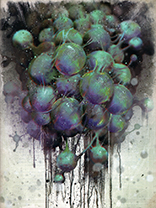 The All-In-One! The heavens are rent by its passing. From without it shall come, a frothing conglomeration of spheres of unearthly hue, each joined by threads of rippling and protoplasmic flesh, flowing outward and inward. All parts bursting and renewing, dripping, joining, melting, and reshaping. Ever-expanding and contracting, filling the sky.
The All-In-One! The heavens are rent by its passing. From without it shall come, a frothing conglomeration of spheres of unearthly hue, each joined by threads of rippling and protoplasmic flesh, flowing outward and inward. All parts bursting and renewing, dripping, joining, melting, and reshaping. Ever-expanding and contracting, filling the sky.
An immense entity dwelling in the interstices between dimensions, it festers between planes of existence and within the dark spaces where the fabric of space-time may be manipulated and broken. None know its true size as only portions are seen where it interacts with our reality. Even then, its manifestations speak ofit as 100 yards/meters across, while at others it seems to stretch for a mile or more, filling the sky and becoming the heavens above. The malleability of its form may simply be forged by the size of the "holes" it uses to traverse the dimensions or may be limited in some way by the magics of the Elder Ones, who unable to confine this entity, were merely able to shackle it in some limited fashion. As with most things concerning this entity, the truth is unknown.
|
|
|
|
|
December 4, 2021
Fizban's Treasury of Dragons
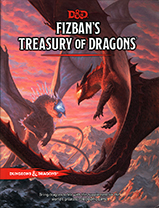 lead designer: James Wyatt
lead designer: James Wyatt
interior artists Mark Behm et al.
cover artists: Anato Finnstark & Chris Rahn
publisher: Wizards of the Coast
publication date: 2021
cover: hardcover
number of pages: 224
ISBN-10: 0-7869-6729-3
ISBN-13: 978-0-7869-6729-2
description: Pertinent to this survey, Chapter 6, from page 159 to 224, is a beastiary. The other chapters describe dragon magic, lairs, hoards, etc. This book is compatible with the 5th edition of the Dungeons & Dragons Role Playing Game.
Our featured entry from this bestiary is the deep dragon.
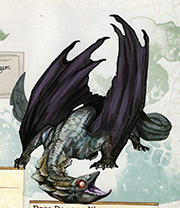 Making their lairs in the depths of the Underdark, deep dragons are nightmarish cousins of chromatic dragons. The warped magical energy of their subterranean realm gives them the ability to exhale magical spores that instill fear and scar the mind.
Making their lairs in the depths of the Underdark, deep dragons are nightmarish cousins of chromatic dragons. The warped magical energy of their subterranean realm gives them the ability to exhale magical spores that instill fear and scar the mind.
Deep dragons' black-and-gray hide is smooth like a salamander's, and their eyes are pale. As they age, their spore breath causes fungi to bloom across their skin, especially around the head and neck. Their wings are attached to their front legs and can fold in close to the body, allowing deep dragons to easily maneuver through relatively narrow tunnels.
Deep dragons often hoard secrets, delighting in knowledge of far-off lands. Many seek out new insights and tricks that they can use against other denizens of the Underdark, preferring social manipulation and crafty dealmaking to exerting themselves in combat. Deep dragons look down on any creature that isn't useful to them, though they are willing to bargain for knowledge they lack.
|
|
|
|
|
Continue to 2022 entries.
|
|
|
|
|
|
|
|

